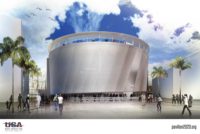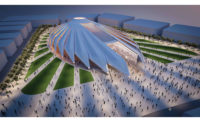Multicolored aluminum “threads” wrap the domes of the Russian pavilion, designed by Moscow-based SPEECH Tchoban & Kuznetsov for Dubai’s World Expo. Photographed by RECORD contributor Roland Halbe, the structure’s playful and colorful interwoven lines—actually 1,000 aluminum tubes bent at various angles and coated with six shades of polymer—recall contour techniques of the avant-garde Russian Constructivists. The 38,000-square-foot pavilion, which is surrounded by a reflecting pool, is meant to prompt visitors to meditate on the interconnectedness of global innovation while providing “a lesson about the important contributions of Russian thinkers,” says Halbe. As a spotlight on creativity, the structure contains examples of the work of Leo Tolstoy, Wassily Kandinsky, and the scientist Dmitri Mendeleev, as well as a modern-day immersive artwork, The Mechanics of Wonder—a kinetic sculpture of the human brain that appears to float—by Konstantin Petrov and Simpateka Entertainment Group. The vibrant pavilion accompanies others from more than 190 nations at the Expo, which opened October 1, following a year-long delay due to the pandemic (it’s still called Expo 2020 Dubai). What is the ongoing allure of such international fairs? As Halbe puts it, “Meeting the world physically, firsthand, is a way to explore the cultural diversity of our planet in condensed little trips from pavilion to pavilion.”
Snapshot: The Russian Pavilion by SPEECH Tchoban & Kuznetsov at Expo Dubai

The Russian Pavilion. Photo © Roland Halbe




Post a comment to this article
Report Abusive Comment